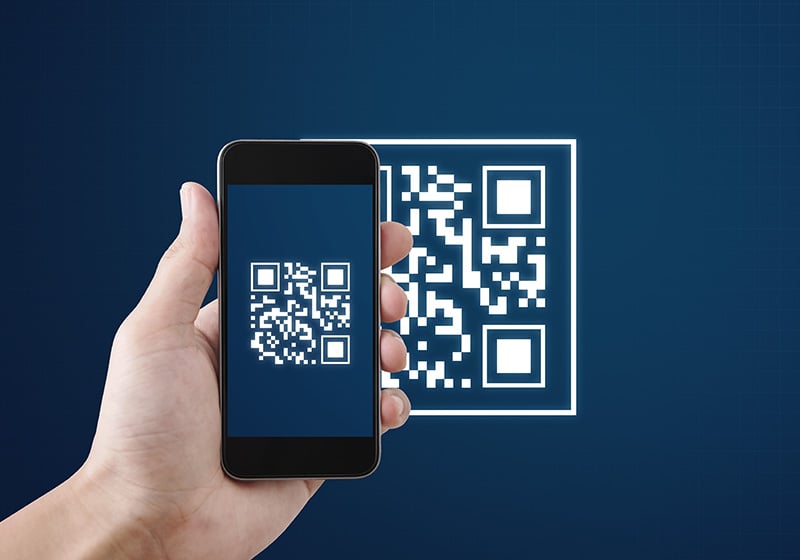Table of Contents
QR codes as a marketing strategy
In April 2021, an army of 1,500 drones were deployed to reproduce in detail a giant QR code in the sky over Shanghai, to the astonishment of passers-by. The purpose was to promote the first anniversary of the Chinese launch of the Japanese video game Princess Connect! Re: Dive. In addition to the QR code, the drones also formed images depicting various characters from the game.
A similar event took place in March of this year, when a drone light show was held in Austin to promote ‘Halo’, the new sci-fi series from Paramount+. The QR code took users to a website to view the trailer and a countdown to the series’ release.
In a post-Covid-19 world, being able to securely access information about products and services is more important than ever. But besides just being used to read a restaurant menu, QR codes offer innovative marketing opportunities in areas such as shopping malls, billboards, interactive TV, interactive displays and non-fungible tokens (NFTs). This is the central thesis of Insider Intelligence’s report ‘QR Codes Forecast and Trends 2022‘.
What is a QR code?
Let’s start at the beginning. QR stands for ‘quick response’ and refers to a two-dimensional barcode that allows instant access to information from a mobile device. This technology enables interactions between a brand and a consumer, which is why they usually appear next to a product or advert.
Although Denso Wave announced the launch of the QR code back in 1994, the technology did not reach the general public until the advent of smartphones. The fact that it required an additional app to work also greatly hindered the user experience, until Google and Apple added QR readers to their in-built cameras in 2017.
At present, the QR code is not the most popular smartphone functionality, but its future prospects since the pandemic are quite promising. According to the Insider Intelligence report, the number of US mobile phone users scanning a QR code will increase from 83.4 million in 2022 to 99.5 million in 2025.
Reasons to use QR codes
One of the main reasons to include QR codes in a marketing campaign is that they are extremely easy to generate. There are countless apps available online, and the Google Chrome browser allows you to generate and download the code for a web page simply by right-clicking on it. They are also easy to read; most mobile phones already scan them directly, as mentioned above.
Moreover, QR technology can be incorporated in many places, from billboards to websites, social media, business cards, catalogues, product labels, etc., and this additional information can be retrieved at any time. Online retailers can evaluate whether purchases increase if the code redirects to their website, for example. And it is undoubtedly a great way to stand out from the competition.
Innovative uses of QR codes
In the marketing world, there are some truly innovative uses for QR codes. They provide access to audiovisual materials such as adverts or corporate videos, or to discounts, coupons and promotions. Major companies are now pushing the envelope with concepts that go beyond the expected.
For example, Amazon has announced that it will open its first physical fashion store later this year in Los Angeles: Amazon Style. Customers will be able to find a selection of clothing, shoes and accessories with a completely new shopping experience. As they walk through the shop, they will be able to scan the QR code on items with the Amazon Shopping app to see sizes, colours, ratings from other customers and additional product details. And with the touch of a button, items will be sent directly to the fitting room, or to the cashier if they don’t need to try them on.
Lately, we have also witnessed the expansion of QR technology in major TV channels around the world. In Spain, the public service broadcaster RTVE has used on-screen codes during news programmes to give more details of the eruption of the volcano on La Palma, for example. They have also been used to track vote counts in elections or local Covid 19 situations.
In 2019, Porsche released a statement that left fans around the world dumbfounded. The iconic horse which has been featured on its emblem since 1952, would be replaced on their new electric Taycan car by a QR code. The new crest “shows the world that Porsche leads the way in digitalization and is still one of the most innovative car companies in the world,” they stated. When trying to access the QR information, users were redirected to a website where it was revealed that the ad was an April Fools’ Day prank, which in itself was a marketing ploy.
At the most recent Super Bowl, viewers had to ‘sit through’ a 60-second ad that showed nothing more than a QR code that changed colour and moved slowly across a black background. Scanning the code took them to the Coinbase website, which urged visitors to do “less talk, more Bitcoin.” To give an idea of how much the cryptocurrency company invested in this ad, NBC Sports revealed that the price of 30 second ads was around $6.5 million.
In 2021, fashion and lifestyle magazine Vogue launched its September issue of the Singapore print edition with a QR code emblazoned on the cover and the headline ‘New Beginnings’. Scanning the code unlocked two digital-exclusive covers, available as NFTs. “The end result is nothing short of metaverse magic,” stated the company, who created the covers in collaboration with local and international digital designers.
The use of QR codes as a gateway to the metaverse is just one example of the new phase that this technology is now entering as a powerful marketing tool.

